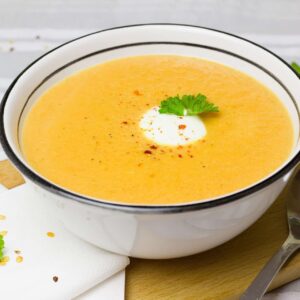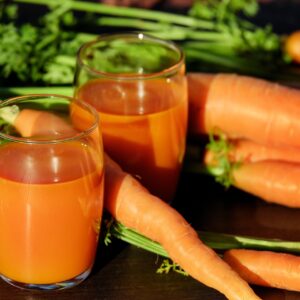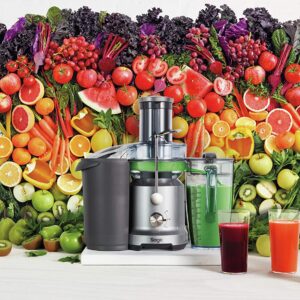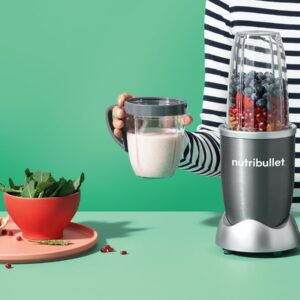Nutrition plays an important role in our immunity and greatly impacts our well-being. From its Viva Collection of kitchen appliances, the Philips juicer brings a fast and easy way to extract most of the valuable nutrition swiftly and directly into your glass. It can handle most ingredients and doesn’t take up too much space on the kitchen counter compared to other centrifugal juicers. Find more in this Philips juicer review.
JUMP TO:
Philips Juicer Review & Buyer’s Guide
The Philips juicer is a centrifugal juicer. It presses the ingredients on a cutting blade disc, rotating at a high speed, to shred them finely. The centrifugal force will pull out the released juice. Then, the juice passes through the fine mesh, leaving dry leftover pulp in the waste container.
Centrifugal machines extract juice much faster compared to cold-pressed juicers. The downside is that this process is quite loud. You should keep this in mind, especially if the kitchen is near the bedroom. Otherwise, your housemates may wake up thinking you are cooking breakfast with a power drill.
The good news is that the 500W version, the superstar of this review, is a lot more silent than bigger models. Or even other brands that I have used before. Remember that it still belongs to the louder category of kitchen appliances.
 Philips HR1832/01 Viva Collection Compact Juicer
Philips HR1832/01 Viva Collection Compact Juicer
- This is a reliable machine made by Philips, a renowned kitchen appliance brand.
- This centrifugal type of juicer allows quick extraction of most kinds of fruit and vegetables. The ingredients don't require much preparation before juicing. You can throw washed carrots, beetroots and watermelon down the feeding chute without peeling or deseeding. You may only have to cut the ingredients into smaller pieces as the feeding chute is less wide.
- The dry, leftover pulp is being collected in a waste compartment.
- The juicer will make enough juice for two or three people until it has to be emptied.
- A 500W motor delivers great juicing performance comparable to the bigger, more powerful models in the same category.
- The price, size and features make it a great entry-level juicer. Read my detailed review here.
- Smaller size
- Powerful juicing performance
- Powerful motor
- Affordable price
- Smaller feeding chute
- No speed setting
Raw vegetables and fruit pack the most minerals and vitamins essential for our wellbeing. Juicing is one of the best methods to extract valuable nutrition directly from the raw ingredients. Did you know that most fruit and vegetables contain over 85% liquid?
The juicer extracts the liquid within the fibres directly, whereas blending fruit and vegetables will chop and blend everything together. It may remind more of a cold soup than a smoothie. Juice is much easier to digest by separating the pulp, which contains most of the fibres, allowing us to intake the nutrition much faster.
When we think about fresh juice, we should think beyond just oranges. The Philips juicer can swallow most of your fridge or garden’s fruit and veggies. The 500W motor is powerful enough to squeeze almost every drop, leaving just the dry pulp in the tray. It juices hard ingredients especially well. Carrots, apples, zucchini, and raw beetroots. I love including beetroots in my diet; however, I am not keen on boiling or roasting them for hours. The Philips juicer can extract valuable nutrients from beetroots in seconds and serve it as a delicious juice. Try it with fresh mint and a piece of lime. Soft fruits are better for smoothies, in my opinion, but you can still include berries in your juice recipes. Juicing leafy vegetables is also possible but a bit tricky as they are very soft. Ingredients like spinach or kale should be juiced in a larger quantity simultaneously to create some pressure on the blade disc.
The centrifugal process mixes juice with air, creating a thick mousse-like foam. Unfortunately, that makes it oxidize and quickly start losing its nutritional value. That’s why the juice is best drunk directly after juicing.
The Philips juicer is made with the focus on easier cleaning. To see if the designers succeeded, keep reading further. I want to highlight the design, notably the see-through lid and pulp container. It makes the whole juicing experience visually very entertaining, especially to the family’s younger members. The juicer is easy and simple to use. Even kids can have a go. It is designed to be very safe, even though it is made to cut things. Watching how carrots and apples are being shredded into pieces in the blink of an eye can spark their interest in helping around the kitchen more. If your kids are reluctant to eat vegetables, like my wife, this juicer can turn it into a playful activity. Turn Saturday mornings into family time and let them devise their own juice recipes. Set some rules to make it challenging that they must use a specific ingredient. They may discover new flavours, get creative and become more open to eating vegetables. Hopefully, they will help you with cleaning after the juicing session as well. Just don’t let them use the machine without the supervision of an adult.
Philips Juicer: Specifications
-
Philips Juicer
-
Capacity:
1.5 litres
-
Number of Speed/s:
1
-
Material:
Plastic
-
Auto Shutoff:
No
-
Power / Wattage:
500 watts
-
Product Dimensions:
15 x 17 x 31 cm
-
Weight:
1.86 kg
Features And Benefits
Easy To Use
Using a Philips juicer is simple. Ingredients must be pushed safely with a paddle through a feeding chute on top. This funnel points directly to the blade disc, spinning at high speed.
The machine was designed to juice fruit and veg without peeling or cutting. It is impressive that it can juice an unpeeled lemon or pineapple with skin still on. Whatever you decide to juice, refer to the user manual first. And don’t forget to wash your ingredients.
When I make carrot juice, I wash a whole carrot and a small apple, cut a piece of ginger and feed them to the juicer. Juicing without any peeling, deseeding, or cutting saves a lot of time.
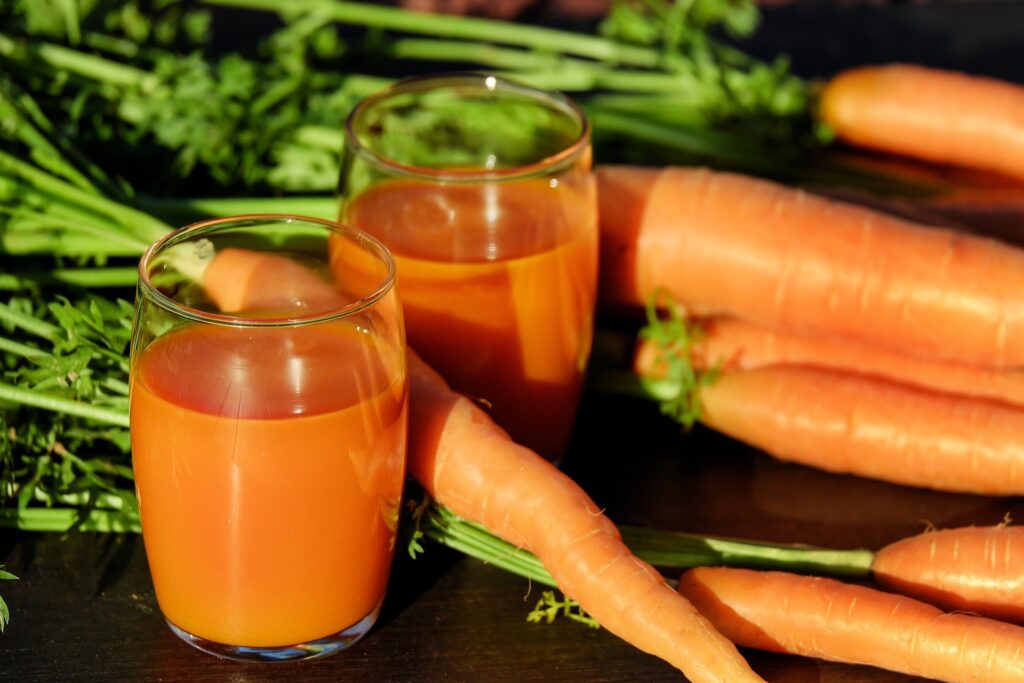
Additional accessories like a berry funnel can be used in case you have a lot of berries to juice. It is sold, unfortunately, separately. I would love to have it in my parent’s house in autumn when the grapes are juicy and plentiful. Or at the peak of strawberry season.
Small Size, Big Juicing Potential
I prefer this model to the bigger ones for its small, compact size while still delivering powerful juicing performance. It will fit most kitchens. You won’t regret buying the Philips juicer for occupying the kitchen counter when you don’t use it every day. It doesn’t take much space, and It can be easily stored in a cupboard.
While small, its juicing capabilities will still satisfy most juice buffs. The waste container is big enough to hold a lot of pulp left after juicing before it needs to be emptied. It depends, though, on what you will use. For example, a watermelon will give a lot of juice and a little pulp, while spinach will do the opposite.
Drip Stop
A small feature, but worth mentioning. At the end of a pour spout, a translucent part controls and directs the flow of fresh juice, which Philips calls a Drip Stop. Twisting it sideways will prevent the leftover juice from dripping onto the counter when there is no jug under the spout. In older models, you had to place an empty glass under it when you removed the full jug. It is convenient for making juice directly into the glass without any splashes.
Cleaning
Cleaning centrifugal juicers is always a pain. The machine needs to be broken apart and washed. Many components are usually big and bulky. The Philips juicer is different from the others in the category of centrifugal juicers. The disassembly is simple and the parts are not that big, it won’t take too much space in the sink or a dishwasher, compared to a bigger one I had before. The pulp can be thrown into a bin or composted in your garden if you have one.
The stainless mesh separating the juice from the pulp usually needs some scrubbing as the fibres get stuck in the fine holes. Most of the time, it can be rinsed under a tap water stream.
Philips boasts that this juicer can be cleaned in just one minute. I think it is a bit more than that, however cleaning is still simple and doesn’t take much time or effort.
How Does It Compare With Bigger Models?
Bigger models have a wider feeding tube. It can swallow bigger ingredients that must be cut on a smaller model. They come with a more powerful motor and a bigger jug to juice more in one go. But they are more pricey and a lot louder. I think the smaller version does the job perfectly. If I need to make juice for more people, I’ll empty the pulp container and carry on squeezing the soul out of the remaining fruits or vegetables.
Best Used For

Philips juicer is most suitable for hard vegetables or fruit like pineapple. It is very easy to use. Cleaning requires some attention; however, it is not much of a hassle and won’t take much time, thanks to thoughtful design.
People wishing to improve their immune systems will find this machine useful as it is one of the fastest ways to include quality nutrition into a daily diet.
Reasons To Buy
Compared to other models, smaller sizes can make it fit in kitchens of all sizes. It is one of my favourite features. Powerful performance can chew most fruits and vegetables in our fridge, unpeeled, washed, and occasionally cut. Extracting almost every drop of liquid that they contained. The proof is the dry pulp left after the extraction and the glass full of juice.
<<Our Testing and Review Methodology>>
Frequently Asked Questions
Can You Make Nut Milk With The Philips Juicer?
No, it cannot process nuts and fruit with a big stone.
Can Philips Juicer Make Juice From Avocado?
No, it cannot. Avocados and fruits like papaya or mango are difficult to extract juice from on a centrifugal juicer.
My Philips Juicer Doesn’t Work.
Check if it has been assembled properly. Make sure that the safety clamps fit in place properly.
Why Does My Philips Juicer Slow Down During Use?
The pulp container is probably full. Empty the container and try again.
Summing Up
I remember the weekends when my father spent half the morning juicing oranges to get 4 glasses of fresh juice. With that in mind, how great it is that making fresh juice these days takes only a few minutes, including cleaning.
Being capable of processing various types of fruit and ingredients will not limit our options or creativity.
The Philips juicer can make a quick, nutritious boost in the morning and anytime during the day.




